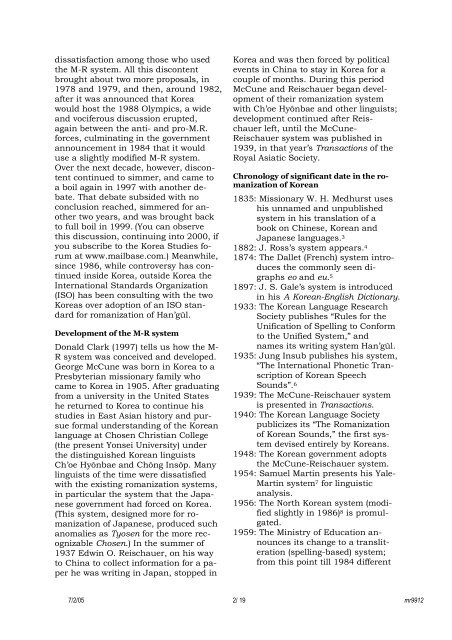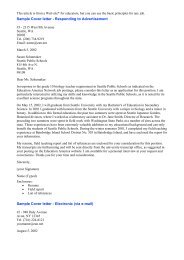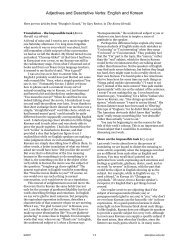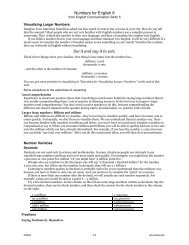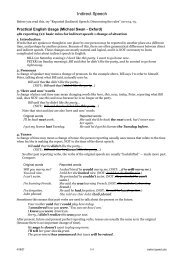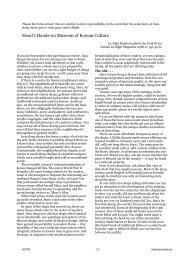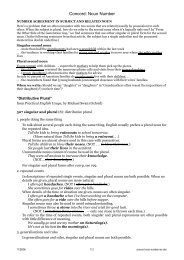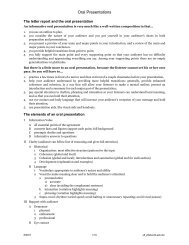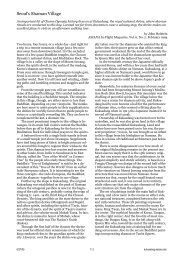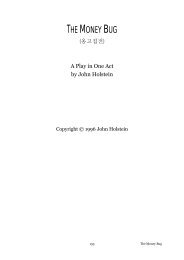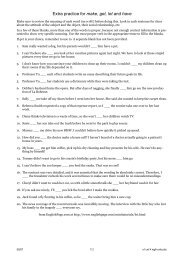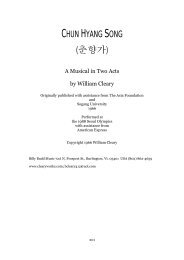The McCune-Reischauer Korean Romanization ... - Korea Mosaic
The McCune-Reischauer Korean Romanization ... - Korea Mosaic
The McCune-Reischauer Korean Romanization ... - Korea Mosaic
You also want an ePaper? Increase the reach of your titles
YUMPU automatically turns print PDFs into web optimized ePapers that Google loves.
dissatisfaction among those who used<br />
the M-R system. All this discontent<br />
brought about two more proposals, in<br />
1978 and 1979, and then, around 1982,<br />
after it was announced that <strong>Korea</strong><br />
would host the 1988 Olympics, a wide<br />
and vociferous discussion erupted,<br />
again between the anti- and pro-M.R.<br />
forces, culminating in the government<br />
announcement in 1984 that it would<br />
use a slightly modified M-R system.<br />
Over the next decade, however, discontent<br />
continued to simmer, and came to<br />
a boil again in 1997 with another debate.<br />
That debate subsided with no<br />
conclusion reached, simmered for another<br />
two years, and was brought back<br />
to full boil in 1999. (You can observe<br />
this discussion, continuing into 2000, if<br />
you subscribe to the <strong>Korea</strong> Studies forum<br />
at www.mailbase.com.) Meanwhile,<br />
since 1986, while controversy has continued<br />
inside <strong>Korea</strong>, outside <strong>Korea</strong> the<br />
International Standards Organization<br />
(ISO) has been consulting with the two<br />
<strong>Korea</strong>s over adoption of an ISO standard<br />
for romanization of Han’gûl.<br />
Development of the M-R system<br />
Donald Clark (1997) tells us how the M-<br />
R system was conceived and developed.<br />
George <strong>McCune</strong> was born in <strong>Korea</strong> to a<br />
Presbyterian missionary family who<br />
came to <strong>Korea</strong> in 1905. After graduating<br />
from a university in the United States<br />
he returned to <strong>Korea</strong> to continue his<br />
studies in East Asian history and pursue<br />
formal understanding of the <strong><strong>Korea</strong>n</strong><br />
language at Chosen Christian College<br />
(the present Yonsei University) under<br />
the distinguished <strong><strong>Korea</strong>n</strong> linguists<br />
Ch’oe Hyônbae and Chông Insôp. Many<br />
linguists of the time were dissatisfied<br />
with the existing romanization systems,<br />
in particular the system that the Japanese<br />
government had forced on <strong>Korea</strong>.<br />
(This system, designed more for romanization<br />
of Japanese, produced such<br />
anomalies as Tyosen for the more recognizable<br />
Chosen.) In the summer of<br />
1937 Edwin O. <strong>Reischauer</strong>, on his way<br />
to China to collect information for a paper<br />
he was writing in Japan, stopped in<br />
<strong>Korea</strong> and was then forced by political<br />
events in China to stay in <strong>Korea</strong> for a<br />
couple of months. During this period<br />
<strong>McCune</strong> and <strong>Reischauer</strong> began development<br />
of their romanization system<br />
with Ch’oe Hyônbae and other linguists;<br />
development continued after <strong>Reischauer</strong><br />
left, until the <strong>McCune</strong>-<br />
<strong>Reischauer</strong> system was published in<br />
1939, in that year’s Transactions of the<br />
Royal Asiatic Society.<br />
Chronology of significant date in the romanization<br />
of <strong><strong>Korea</strong>n</strong><br />
1835: Missionary W. H. Medhurst uses<br />
his unnamed and unpublished<br />
system in his translation of a<br />
book on Chinese, <strong><strong>Korea</strong>n</strong> and<br />
Japanese languages. 3<br />
1882: J. Ross’s system appears. 4<br />
1874: <strong>The</strong> Dallet (French) system introduces<br />
the commonly seen digraphs<br />
eo and eu. 5<br />
1897: J. S. Gale’s system is introduced<br />
in his A <strong><strong>Korea</strong>n</strong>-English Dictionary.<br />
1933: <strong>The</strong> <strong><strong>Korea</strong>n</strong> Language Research<br />
Society publishes “Rules for the<br />
Unification of Spelling to Conform<br />
to the Unified System,” and<br />
names its writing system Han’gûl.<br />
1935: Jung Insub publishes his system,<br />
“<strong>The</strong> International Phonetic Transcription<br />
of <strong><strong>Korea</strong>n</strong> Speech<br />
Sounds”. 6<br />
1939: <strong>The</strong> <strong>McCune</strong>-<strong>Reischauer</strong> system<br />
is presented in Transactions.<br />
1940: <strong>The</strong> <strong><strong>Korea</strong>n</strong> Language Society<br />
publicizes its “<strong>The</strong> <strong>Romanization</strong><br />
of <strong><strong>Korea</strong>n</strong> Sounds,” the first system<br />
devised entirely by <strong><strong>Korea</strong>n</strong>s.<br />
1948: <strong>The</strong> <strong><strong>Korea</strong>n</strong> government adopts<br />
the <strong>McCune</strong>-<strong>Reischauer</strong> system.<br />
1954: Samuel Martin presents his Yale-<br />
Martin system 7 for linguistic<br />
analysis.<br />
1956: <strong>The</strong> North <strong><strong>Korea</strong>n</strong> system (modified<br />
slightly in 1986) 8 is promulgated.<br />
1959: <strong>The</strong> Ministry of Education announces<br />
its change to a transliteration<br />
(spelling-based) system;<br />
from this point till 1984 different<br />
7/2/05 2/ 19 mr9912


